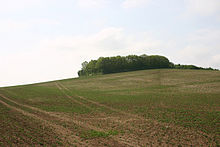Cnut's invasion of England
| Cnut the Great's Invasion of England | |||||||||
|---|---|---|---|---|---|---|---|---|---|
| Part of the Viking Invasions of England | |||||||||
 Ashingdon hill, possible location of the battle of Assandun | |||||||||
| |||||||||
| Belligerents | |||||||||
| Kingdom of Denmark | Kingdom of England | ||||||||
| Commanders and leaders | |||||||||
| Cnut the Great | Edmund II Eadnoth the Younger † Ulfcytel Snillingr † | ||||||||
| Strength | |||||||||
| unknown | unknown | ||||||||
| Casualties and losses | |||||||||
| unknown | unknown | ||||||||
In the autumn of 1016, the Danish prince Cnut the Great (Canute) successfully invaded England. Cnut's father, Sweyn Forkbeard, had previously conquered and briefly ruled England for less than five weeks.
Battle of Brentford[edit]
The Battle of Brentford was fought in 1016 some time between 9 May (the approximate date Cnut landed at Greenwich) and 18 October (the date of the later Battle of Assandun) between the English led by Edmund Ironside and the Danes led by Cnut. It was one of a series of battles fought between Edmund and Cnut, ultimately resulting in the lands held by Edmund's father Ethelred the Unready being divided between the two. Edmund was victorious in this particular battle, but ultimately failed to defend the lands inherited from his father.
"Then collected he [Edmund] his force the third time, and went to London, all by north of the Thames, and so out through Clayhanger, and relieved the citizens, driving the enemy to their ships. It was within two nights after that the king went over at Brentford; where he fought with the enemy, and put them to flight: but there many of the English were drowned, from their own carelessness; who went before the main army with a design to plunder.(Anglo-Saxon Chronicle)"
Battle of Assandun[edit]
The Battle of Assandun (or Essendune)[2] was fought between Danish and English armies on 18 October 1016. There is disagreement whether Assandun may be Ashdon near Saffron Walden in north Essex or, as long supposed, Ashingdon near Rochford in southeast Essex, England. It ended in victory for the Danes, led by Canute the Great, who triumphed over the English army led by King Edmund Ironside. The battle was the conclusion to the Danish reconquest of England.
The battle is mentioned briefly in Knýtlinga saga which quotes a verse of skaldic poetry by Óttarr svarti, one of Cnut's court poets.
King Knut fought the third battle, a major one, against the sons of Æthelred at a place called Ashingdon, north of the Danes' Woods. In the words of Ottar:
- At Ashingdon, you worked well
- in the shield-war, warrior-king;
- brown was the flesh of bodies
- served to the blood-bird:
- in the slaughter, you won,
- sire, with your sword
- enough of a name there,
- north of the Danes' Woods.[3]
During the course of the battle, Eädnoth the Younger, Bishop of Dorchester, was killed by Cnut's men whilst in the act of saying mass on behalf of Edmund Ironside's men. According to Liber Eliensis, Eadnoth's hand was first cut off for a ring, and then his body cut to pieces.[4] The Ealdorman Ulfcytel Snillingr also died in the battle.[citation needed]
Consequences[edit]
Following his defeat, Edmund was forced to sign a treaty with Cnut. By this treaty, all of England except Wessex would be controlled by Cnut and when one of the kings should die the other would take all of England, that king's son being the heir to the throne. After Edmund's death on 30 November, Cnut built a church, chapel or holy site after winning the battle to commemorate the soldiers who died in battle. A few years later in 1020 the completion took place of the memorial church known as Ashingdon Minster, on the hill next to the presumed site of the battle in Ashingdon. The church still stands to this day. Cnut attended the dedication of Ashingdon Minster with his bishops and appointed his personal priest, Stigand, to be priest there. The church is now dedicated to Saint Andrew but is believed previously to have been dedicated to Saint Michael, who was considered a military saint: churches dedicated to him are frequently located on a hill.[citation needed]
References[edit]
- ^ "Edmund II (king of England)". Brittanica. Retrieved 25 March 2010.
- ^ Smith, Ernest F. (1916). Fairbairn, W. H. (ed.). Tewkesbury Abbey. Notes on Famous Churches and Abbeys. [1916]. London: SPCK. p. 2.
- ^ "Knut's Invasion of England in 1015-16, according to the Knytlinga Saga". De Re Militari. Archived from the original on 26 September 2011. Retrieved 17 October 2011.
- ^ Fairweather, Janet, trans., Liber Eliensis (Woodbridge, 2005), p. 169


 French
French Deutsch
Deutsch